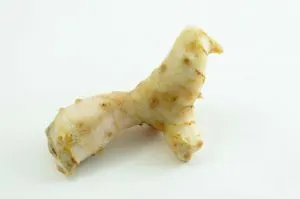Most everyone is familiar with the distinctive, spicy-sweet taste of ginger, but galangal remains a mystery to many of us who are not versed in Southeast Asian cuisine. Throughout Thailand, Indonesia, Malaysia and Vietnam, however, galangal has been used for both culinary and medicinal purposes for centuries.
Scientifically known as Alpinia galanga, galangal is also sometimes called Siamese ginger, blue ginger or Chinese ginger. It is part of the rhizome family along with ginger and turmeric, which is characterized by an underground stem that sends shoots to the surface of the soil to grow the above-ground part of the plant. The galangal plant has long stems reminiscent of reeds, large leaves, and green flowers that resemble orchids. It flourishes in rainforest climates.
Compared to ginger, galangal is larger, harder, has lighter-colored skin, and sometimes has pinkish patches. The flavor is somewhat different from that of ginger, as well. There are two main types of galangal.
The first is Indonesian galangal, or lengkuas, which has an earthy flavor and a somewhat piney scent. This is the type most commonly found in the West. The second type is krachaai galangal, which originated in China and is popular in Thailand. Krachaai galangal has a flavor that resembles a cross between ginger and pepper.
Like ginger, galangal has anti-inflammatory properties, and may be beneficial to those suffering from rheumatoid arthritis and other inflammatory, chronic illnesses. It is traditionally used to soothe stomach pain, stimulate appetite, curb nausea, motion sickness and diarrhea, and ease the pain of ulcers. Galangal contains a range of disease-fighting antioxidants, including flavonoids and vitamins A and C, and is a great source of iron.
On top of that, this delicious rhizome may help to improve circulation, and possesses antibacterial and antispasmodic characteristics. In Southeast Asia, galangal is often combined with lime juice and used as a health tonic for colds and coughs.
Cooking with galangal is similar to cooking with ginger, except that it takes longer for it to become tender when cooked. To add to dishes, peel and slice it into thin strips and add to stir fries, stews and sauces, or grind the strips in a hardy spice grinder to add raw to salads and other raw dishes. Galangal is an essential ingredient in many Thai recipes, and substituting ginger will not achieve the same flavor.

While it may be a bit harder to find than ordinary ginger, the culinary and nutritional benefits that galangal offers are well worth the search.
-The Alternative Daily
Sources:
http://timesofindia.indiatimes.com/life-style/health-fitness/diet/Benefits-of-Galangal/articleshow/8065447.cms
http://www.thaifood.food-recipe-cooking.com/galangal-01.htm
http://www.thekitchn.com/ingredient-spotlight-what-is-g-43841
http://www.naturaltherapypages.com.au/article/what_is_galangal
http://www.anniesremedy.com/herb_detail481.php
http://www.home-remedies-for-you.com/herbs/galangal.html
